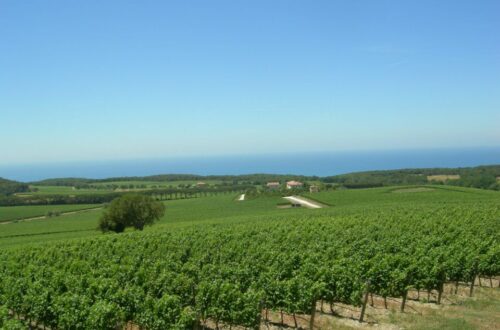At a Glance
| Style | Sardinian oxidative white wine (unfortified, flor-aged) |
| Grape | Vernaccia di Oristano |
| Aging | Minimum 2 years, often via solera system |
| Alcohol | 15–18% |
| Key Flavors | Walnut, almond, dried citrus, sea breeze, spice |
| Price Range | €18–€60 (special vintages > €100) |
| Best Producers | Contini, Silvio Carta, Fratelli Serra, Cantina della Vernaccia |
| Serving Temp | 12–14°C in small tulip-shaped glass |
| Collectibility | Strong for aged vintages |
Table of Contents
History & Origins
In the quiet lagoons of western Sardinia, the town of Oristano has been producing Vernaccia since medieval times. This wine’s character—salty, nutty, and rich—is shaped by the island’s winds, its unique microclimate, and centuries-old cellar traditions. Unlike most Italian whites, Vernaccia di Oristano is made to age, often resting under a veil of yeast known as flor for years, developing its unmistakable oxidative complexity
DOC Regulations
The Vernaccia di Oristano DOC, established in 1971, protects wines made exclusively from Vernaccia grapes grown in specified zones around Oristano.
- Minimum aging: 2 years in oak or chestnut casks
- Riserva: Minimum 3.5 years aging
- Flor aging: Optional but traditional for the most authentic style
- Alcohol: 15–18%
- Dry or sweet styles permitted
How Vernaccia di Oristano Is Made
Production relies on oxidative aging and in many cases the solera system, where younger wines refresh older barrels over decades. This results in a seamless blend of vintages, deepening complexity.
Key Winemaking Steps:
- Late harvest to achieve higher sugars
- Gentle pressing and fermentation
- Transfer to partially filled casks, encouraging flor development
- Long, slow maturation in well-ventilated cellars
Vernaccia di Oristano vs Sherry: Key Differences
| Feature | Vernaccia di Oristano | Spanish Sherry |
| Base grape | Vernaccia | Palomino (mainly) |
| Fortification | None | Usually fortified with brandy |
| Climate | Mediterranean island | Andalusian coast |
| Aging | Often solera, always oxidative | Solera, oxidative and/or biological |
| Flavor | More saline, almond-driven | Broader range, includes sweeter PX styles |
Best Vernaccia di Oristano Producers
- Contini – Historic producer, famed for its Antico Gregori solera dating back over a century
- Silvio Carta – Master of traditional flor aging, also known for striking bottle designs
- Fratelli Serra – Elegant, complex bottlings with pronounced minerality
- Cantina della Vernaccia – Accessible pricing, great entry point for new drinkers
- Orro – Boutique winery producing limited quantities with intense aromatics
Vintage tip: Seek out 1980s and early 2000s Riservas for peak complexity.
How to Age and Store Vernaccia di Oristano
- Cellar temperature: 12–14°C
- Humidity: 65–75%
- Store bottles upright to minimize cork contact with high-alcohol wine
- Can age gracefully for decades—older vintages develop dried fruit, caramel, and herbal notes
Food Pairings
- Sardinian bottarga (cured mullet roe)
- Aged Pecorino Sardo
- Almond-based pastries like amaretti sardi
- Roasted shellfish, especially lobster or langoustine
Where to Buy Vernaccia di Oristano Online
- Italian specialty wine shops (e.g., Callmewine, Tannico)
- International retailers with rare wine sections
- Auction houses for historic vintages
Investment Potential
With limited annual production and increasing interest in oxidative wines, Vernaccia di Oristano has strong collectibility. Rare solera bottlings and Riservas appreciate steadily among enthusiasts.
FAQ
Q: Is Vernaccia di Oristano sweet or dry?
A: Traditionally dry, but sweet versions exist, often labeled dolce.
Q: How long does an open bottle last?
A: Up to two weeks refrigerated, thanks to its oxidative stability.
Q: Why is it compared to Sherry?
A: The flor aging process and oxidative profile evoke Fino or Amontillado styles.
Call to Action
Love discovering rare Italian wines?
- Sign up for our Rare Wine Alerts to hear when historic vintages become available.
- Explore our guides to other Sardinian treasures like Cannonau di Sardegna and Malvasia di Bosa.


